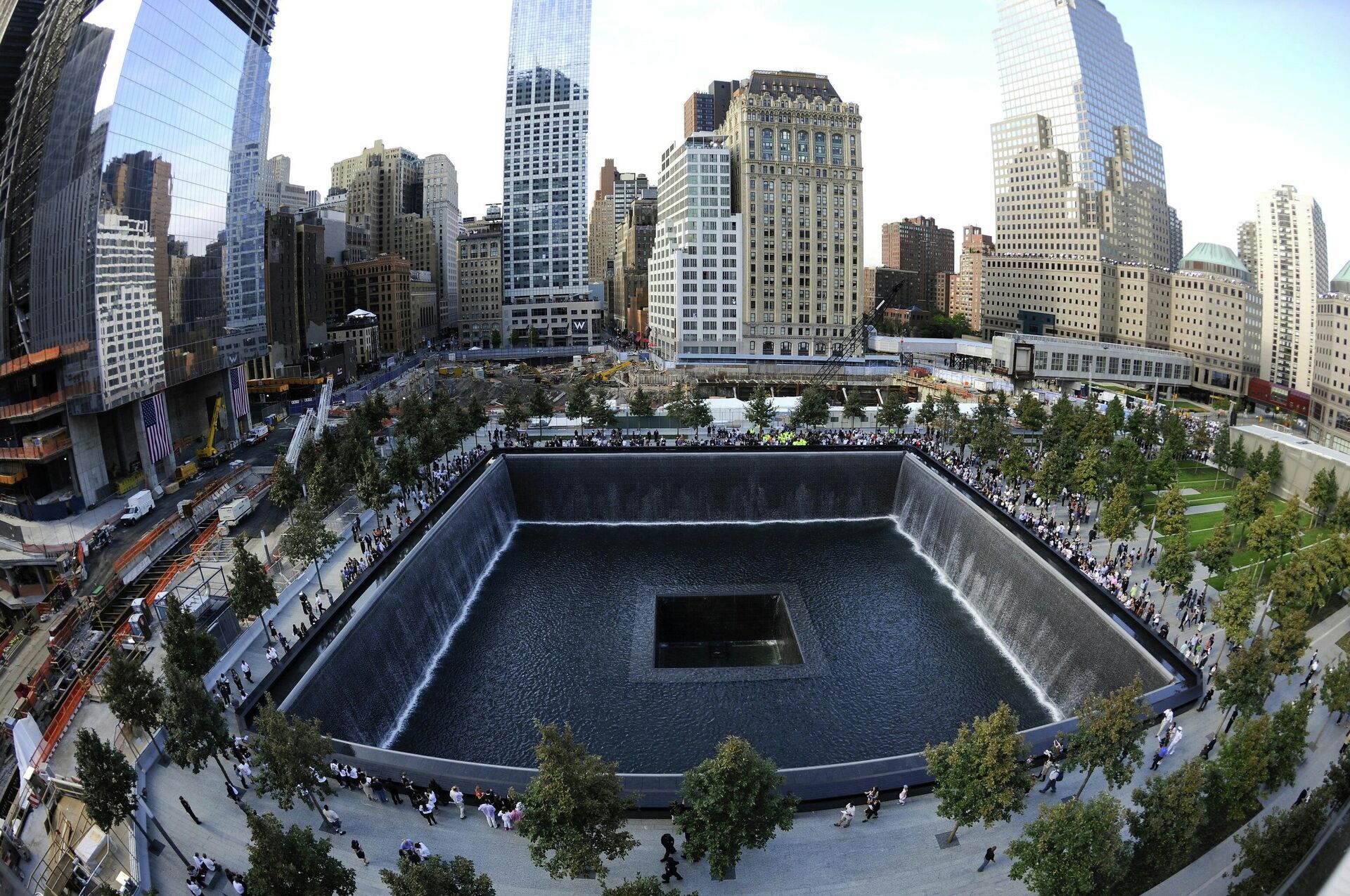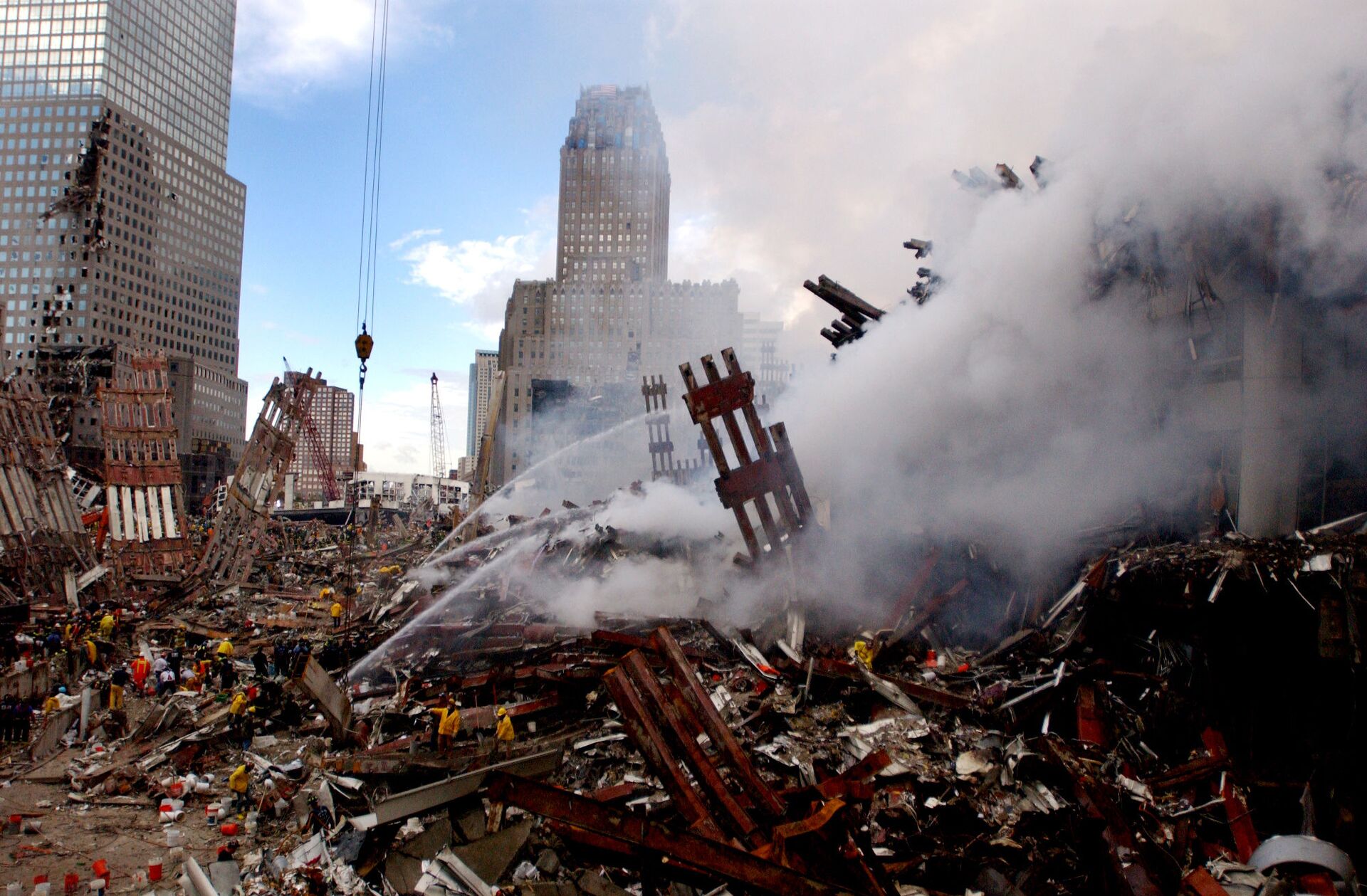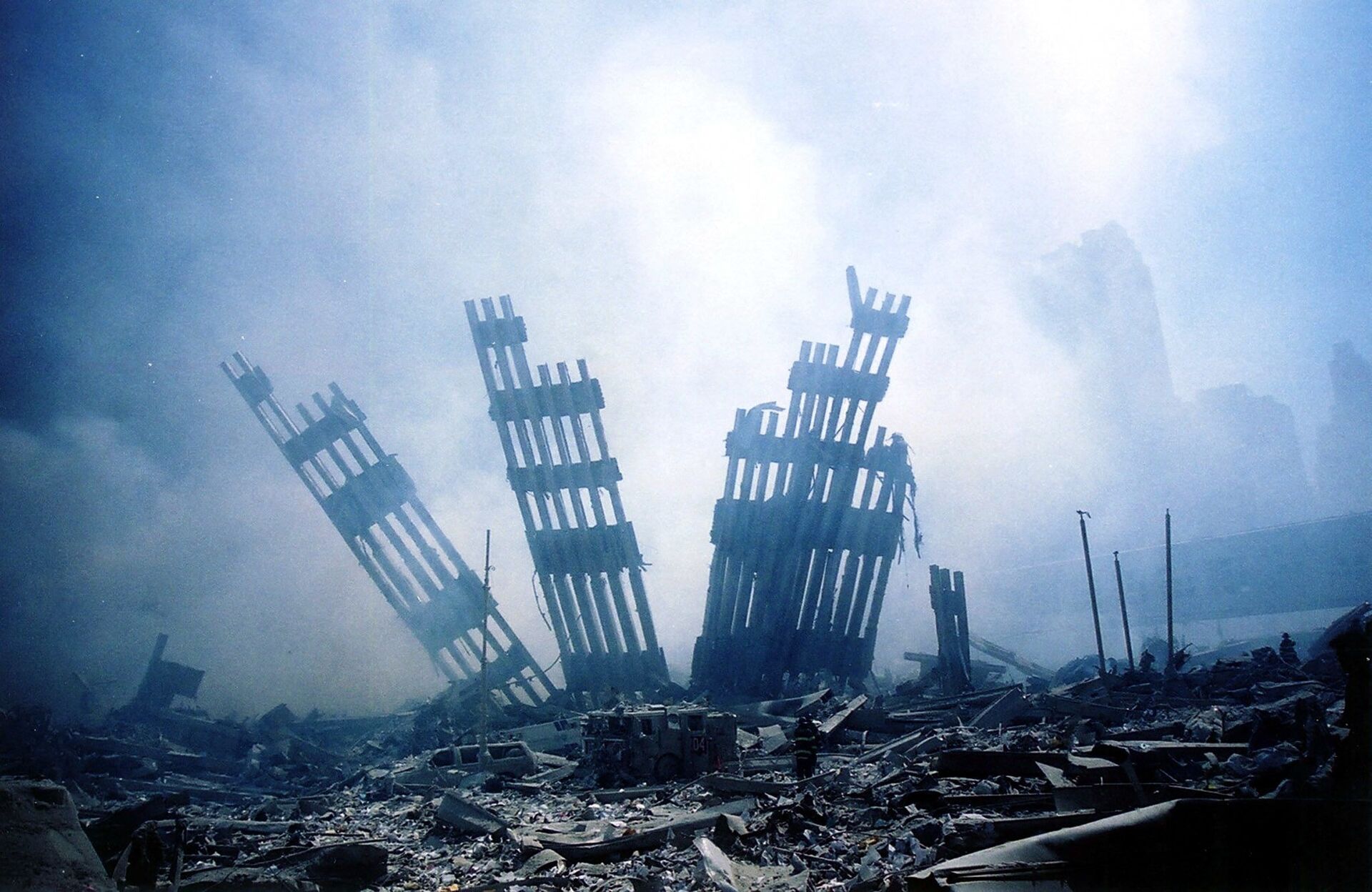Three People, Three Stories, One Tragedy: Witnesses Recall 9/11 on 20th Anniversary
07:26 GMT 11.09.2021 (Updated: 13:24 GMT 06.08.2022)

© Sputnik / Vera Golosova
/ Subscribe
WASHINGTON (Sputnik) Ekaterina Chukaeva - A firefighter who rushed to Ground Zero to save lives, a blind man whose guide dog navigated him and 30 other people to safety through smoke, and a photographer who took the first photos of the tragedy – Sputnik looks at 3 stories of 3 different people who had in common just one thing – the tragedy of 9/11.
Tuesday, 11 September 20 years ago became the black day for the whole of humanity which divided the lives of the majority of the Americans into two parts – before and after. Back then, Al Qaeda* terrorists crashed two hijacked commercial planes in the twin towers of the World Trade Center (WTC) in New York. The third plane hit the Pentagon near Washington, while the fourth hijacked plane fell down in the state of Pennsylvania. Nearly 3,000 people were killed that day and over 25,000 were injured.
According to a recent poll released ahead of the anniversary, nearly two-thirds of US adults say 9/11 permanently changed life in the country, the highest level recorded in two decades.
‘All The Time Wondering How We Get' People Out of Debris
As the reports about the attacks started emerging, thousands of search and rescue workers were rushed to Ground Zero and Greg Hess, a member of the Indianapolis Fire Department, was one of them. He was a member of the Indiana Task Force-1 The Federal Emergency Management Agency (FEMA) Search and Rescue team that travelled to the scene. His team arrived in New York 16 hours after the second tower fell and remained on the scene for eight days.
"The feelings were of utter amazement that there could still be surviving people under the debris. Of course, all the time wondering how were we going to get to them," he told Sputnik when asked about his first feeling when he arrived at the scene.
The job of their team was to assist the remaining rescue personnel. Hess explained that his team was specialized in heavy rescue, rope rescue, confined space rescue and water rescue among other things.
"The most tense time was every moment. We never knew if or when things might change. Especially wondering if the debris pile was going to shift. Plus, there were still fires burning," he recalled.
According to Hess, the disaster affected everyone worldwide and it indeed changed how everyone goes about their lives every day. He admitted that since he was a firefighter and paramedic, he managed to cope with the emotional effects, but "it was still overwhelming."
The dust from the attacks suffused the air of Lower Manhattan with millions of tonnes of construction debris, asbestos, and glass, as well as such chemicals as lead and mercury. The contaminants are known to trigger the development of cancer, serious respiratory illnesses, heart and kidney damage, and other diseases in the human body. Nearly 10,000 first responders and people who were close to the WTC on the day of the attacks have been diagnosed with cancer.

Families visit the South Memorial Pool during tenth anniversary ceremonies at the World Trade Center site in New York, U.S., September 11, 2011
© REUTERS / POOL
Hess was one of those affected by the consequences of the tragedy. In 2007, he was diagnosed with Stage 3A Colon cancer, which was directly related to his exposures at Ground Zero. Of the 62 members of Task Force 1, twenty-six people have come down with various illnesses from Ground Zero and four have died from their illness.
"They have identified 68 different types of cancer in first responders. As of October 2019, more first responders have died from their exposures than victims on 9/11. So the long term effects of 9/11 keep growing and growing," Hess, who spearheaded the project to build the 9/11 Memorial in Indianapolis, concluded.
Hero Dog Roselle Guided People Out of WTC
Back then, on 11 September, not only people were trying to save lives. Some 300 four-legged heroes were involved in the rescue efforts, as well. One of such canines was yellow labrador Roselle, who saved her owner and 30 others by calmly guiding them to safety down 80 floors through the fire, debris and smoke.
Roselle was a three-year-old guide dog for Michael Hingson, a sales manager for Fortune 500 company Quantum, which was planning to do some special sales training seminars that Tuesday. The company’s staff was finishing final preparations when at 8:45 in the morning they heard something that resembled a muffled explosion.
"And then the building shook. It just started tipping. And we actually moved, maybe about 20 feet. It just kept tipping and tipping and tipping. Tall buildings are made to do that if they're struck. It's happened a couple of times before. But we didn't know what happened. Nobody knew what happened," Hingson told Sputnik.
The office of their company was 18 floors below where the plane hit the building and on the other side of the building. Hingson came back over toward his desk where Roselle was – her usual place. She seemed calm. One of Hingson’s colleagues saw fire and started to panic a little bit and said they have to get out of here. Hingson recalled that he tried to calm him down.

Fires still burn amidst the rubble of the World Trade Center, days after the 11 September terrorist attack.
© Photo : Public domain / U.S. Navy / Jim Watson
"The reason I kept telling [him] to slow down ... is that I was observing that Roselle was not doing anything to indicate that she was afraid. She wasn't sensing anything. That told me that whatever was occurring wasn't so close to us that we couldn't try to evacuate in an orderly normal way, which is what we did," he said.
When they were going to the stairs, Hingson suddenly felt an odor of the fumes from burning jet fuel. He did a lot of travel and he knew how the plane fuel smelled.
"When I observed it to other people, they said: ‘Yeah, that's what we're smelling, you are right.’ It must be that we were hit by an airplane," he said.
During their evacuation, Roselle who did not show any fear was receiving commands from Hingson.
"At the top of every flight of stairs, I have to tell her to go forward and if she goes forward then we're doing fine. If she doesn't then there must be a reason. But going down the stairs. She was able to do that. She guides, her job is to make sure that we walk safely," he explained.
After they got outside, they were very close to Tower Two when it collapsed.
"It was certainly very scary but we ran from it. And I guess I can only say when I learned that tower two had collapsed, I was speechless because there was no way to know what had happened and why it happened. And all of a sudden, tower two was gone. And then a few minutes later tower one was gone," he recalled, adding that only when they escaped into safety, he managed to call his wife and finally learned about the terrorist attacks.
Back at home, Roselle acted as if nothing happened and she started playing with Hingson’s retired guide dog, Linnie.
"She focused that she did her job all day and then when we got home she wanted to play. It was over for her. She was very happy that she did a good job of guiding and doing what she was supposed to do. And I kept encouraging her and telling her she was doing a good job. And so when we got home it was over for her, it was done," he said.
Roselle was fine in the beginning but later she contracted a disease called immune-mediated thrombocytopenia, an auto-immune disease where the immune system destroys platelets within the body.
"It [the disease] is usually caused either by genetics which certainly did not make sense in Roselle's case because there was no one in her bloodline that had that. Roselle comes from guide dogs for the blind in California. They have her whole history, her whole family trees. So they knew that this wasn't an issue, but the other way you get it is by Ingesting toxins. And of course, she did that on September 11th. We think that what happened on September 11th eventually affected her. But not immediately," he explained.
Roselle passed away in 2011 at the age of 14. Hingson, who after the tragedy became a motivational speaker, dedicated a book about her and set up Roselle's Dream Foundation to raise money to aid vision-impaired people in everyday life. She was posthumously named American Hero Dog of the Year 2011 by American Humane.
Hingson’s current guide dog is called Alamo. He says 5-year-old Alamo loves cameras and loves to sit on the lap.
That Woman Reminded Me of Figures in Pompeii
Stan Honda was working as a contract photographer for Agence France-Presse when his colleague called him early in the morning to say a plane had crashed into the WTC. Both thought that it was a private plane and they decided to get to the scene.
"I got out [of the subway] and above ground, there were hundreds of people looking up towards the twin towers. The buildings were both still standing and both had smoke coming from them, which confused me. I hadn’t heard of the second plane, so I didn’t know what was going on," he told Sputnik, adding that he started photographing people looking at the tragedy and the buildings, and then ran toward the trade center.
Honda was photographing one of the towers when it broke apart, apparently, this was the first tower collapsing.
"I don’t remember that moment, but a second later there was a huge roar, like a train, that continued for minutes. A giant cloud of smoke and dust appeared, coming in my direction down streets and between buildings. As the cloud advanced, people were running from it," he recalled.
Honda kept on taking photos until it became as dark as night due to the smoke. It was difficult to see anything and eventually, he saw a police officer pulling people into an office building lobby. Honda also went into the lobby. That is where he would take the most famous and iconic pictures of the 9/11 tragedy.
"A woman came in completely covered in dust. She reminded me of the figures seen in photographs from Pompei. Though she had a business dress and boots on, you couldn’t tell what color they were. She paused for a second near the elevators and I took one frame of her. The next second people were helping her up a flight of stairs, to a safer location," he recalled.
After the photo, the woman became known as the "dust lady" in the media. Only in 2002, her identity was released. Her name was Marcy Borders from Bayonne, New Jersey and she was a legal assistant working at the Bank of America in the WTC. Honda and his colleagues went to her to get an interview.

In this file photo the rubble of the twin towers of the World Trade Center smoulder following a terrorist attack in lower Manhattan, New York on September 11, 2001.
© AFP 2023 / ALEXANDRE FUCHS
"When we finally met her, I was relieved to see she wasn’t physically hurt from the experience. It was amazing to hear her story and nice to photograph her in a calmer setting," Honda said.
Marcy was 28 when the tragedy happened and later she admitted that she would never recover from the depression she developed after the attacks. In 2014, she developed stomach cancer which she believed was triggered by the toxic dust she was exposed to during the collapse of the WTC. She died in 2015 at the age of 42.
"I was sad when I heard about her death in 2015. By reading the stories about her, it seemed Marcy had a lot of ups and downs in her life and she had a rough time after the 2001 experience. But her life seemed to be improving until she was diagnosed with stomach cancer. She seemed to be a real survivor of Sept. 11, so it was sad to see her die so young," Honda admitted.
*A terrorist group outlawed in Russia and many other countries.

